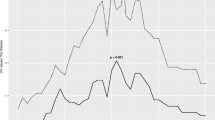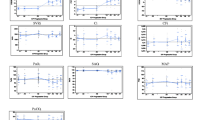Abstract
Objectives
Severe head injury in childhood is associated with considerable mortality and morbidity. In this study we determined age-related differences in the relationship between outcome and intracranial pressure (ICP) and cerebral perfusion pressure (CPP) in the first 6 h of monitoring in a large cohort of head-injured children.
Methods
Two hundred and thirty-five head-injured children (admitted to five UK hospitals over a 15-year period) in whom intracranial pressure monitoring was clinically indicated were studied.
Results
Patients were divided into three age groups (2–6, 7–10 and 11–16 years). The sensitivity of ICP and CPP were similar. Differences were found in the specificity of ICP and CPP for each group and these were more marked for CPP. For a specificity of 50% the pressures were 53, 63 and 66 mmHg for the three age groups.
Conclusions
There are age-related differences in the specificity of intracranial pressure and cerebral perfusion pressure in relation to outcome. These differences may be important in the clinical management of head-injured children. Thus cerebral perfusion pressures of 53, 63 and 66 mmHg should be the minimum to strive for in these three age groups respectively.



Similar content being viewed by others
References
Alberico AM, Ward JD, Choi SC, Marmarou A, Young HF (1987) Outcome after severe head injury. Relationship to mass lesions, diffuse injury, and ICP course in pediatric and adult patients. J Neurosurg 67:648–656
Bouma GJ, Muizelaar JP, Bandoh K, Marmarou A (1992) Blood-pressure and intracranial pressure-volume dynamics in severe head-injury: relationship with cerebral blood-flow. J Neurosurg 77:15–19
Brookes M, MacMillan R, Culloy S, Anderson E, Murray S, Mendelow AD, Jennett B (1990) Head injuries in accident and emergency departments. How different are children and adults? J Epidemiol Community Health 44:147–151
Bullock R, Chesnut RM, Clifton G, American Association of Neurological Surgeons (1996) Guidelines for the management of severe head injury. J Neurotrauma 13:639–734
Chambers IR, Treadwell L, Mendelow AD (2001) Determination of threshold levels of cerebral perfusion pressure and intracranial pressure in severe head injury by using ROC curves: an observational study in 291 patients. J Neurosurg 94:412–416
Changaris DG, McGraw CP, Richardson JD, Garretson HD, Arpin EJ, Shields CB (1987) Correlation of cerebral perfusion-pressure and Glasgow Coma Scale to outcome. J Trauma 27:1007–1013
Chesnut RM, Marshall SB, Piek J, Blunt BA, Klauber MR, Marshall LF (1993) Early and late systemic hypotension as a frequent and fundamental source of cerebral ischaemia following severe brain injury in the Traumatic Coma Data Bank. Acta Neurochir Suppl (Wien) 59:121–125
Hull D, Johnston DI (1981) Essential paediatrics. Churchill Livingstone, Edinburgh, p 134
Jones PA, Andrews PJD, Easton VJ, Minns RA (2003) Traumatic brain injury in childhood: intensive care time series data and outcome. Br J Neurosurg 17:29–39
Lam WH, Mackersie A (1999) Paediatric head injury: incidence, aetiology and management. Paediatr Anaesth 9:377–385
Luerssen TG, Klauber M, Marshall LF (1988) Outcome from head injury related to patient’s age. J Neurosurg 68:409–416
Maas AR, Dearden M, Teasdale GM (1997) EBIC-guidelines for management of severe head injury in adults. Acta Neurochir 139:286–294
Marmarou A, Anderson RL, Ward JD, Choi SC, Young HF, Eisenberg HM, Foulkes MA, Marshall LF, Jane JA (1991) Impact of ICP instability and hypotension on outcome in patients with severe head trauma. J Neurosurg 75:S59–S66
Miller JD (1994) Swelling and blood flow in the injured child’s brain. Lancet 344:421–422
National Collaborating Centre for Acute Care (2003) Head injury: triage, assessment, investigation and early management of head injury in infants, children and adults. National Institute for Clinical Excellence, London
Pfenninger J, Santi A (2002) Severe traumatic brain injury in children—are the results improving? Swiss Med Wkly 132:116–120
Robertson CS, Valadka AB, Hannay HJ (1999) Prevention of secondary ischemic insults after severe head injury. Crit Care Med 27:2086–2095
Rosner MJ, Becker DP (1984) Origin and evolution of plateau waves. Experimental observations and a theoretical model. J Neurosurg 60:312–324
Rosner MJ, Rosner SD, Johnson AH (1995) Cerebral perfusion pressure: management protocol and results. J Neurosurg 83:949–962
Teasdale GM, Gentleman D, The Guideline Development Group (2000) Early management of patients with a head injury. Scottish Intercollegiate Guidelines Network (SIGN)/Royal College of Physicians, Edinburgh
Vollmer DG, Torner JC, Jane JA, Sadovnic B, Charlebois D, Eisenberg HM, Foulkes MA, Marmarou A, Marshall LF (1991) Age and outcome following traumatic coma: why do older patients fare worse? J Neurosurg 75:S37–S49
Acknowledgements
We are grateful to the children, parents and staff at all the Intensive Care Units where we collected and analysed data. Data collection has, in part, been funded by the Chief Scientist Office, Scotland, the Medical Research Council, the British Heart Foundation and the Northern Brainwave Appeal. This work was undertaken by NHS Trusts receiving a proportion of their funding from the NHS Executive. The views expressed in this publication are those of the authors and not necessarily those of the NHS Executive. The sponsors had no role in data analysis or interpretation, writing the paper or the decision to submit for publication.
Author information
Authors and Affiliations
Corresponding author
Rights and permissions
About this article
Cite this article
Chambers, I.R., Stobbart, L., Jones, P.A. et al. Age-related differences in intracranial pressure and cerebral perfusion pressure in the first 6 hours of monitoring after children’s head injury: association with outcome. Childs Nerv Syst 21, 195–199 (2005). https://doi.org/10.1007/s00381-004-1060-x
Received:
Published:
Issue Date:
DOI: https://doi.org/10.1007/s00381-004-1060-x




